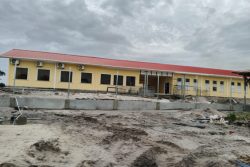(Trinidad Express) Grenadian Prime Minister Tillman Thomas yesterday confirmed his government has been engaged in talks with Trinidad and Tobago about maritime boundary issues.
He told the Express that his government had embarked on talks and had charged Nazim Burke, his Minister of Finance, Planning, Economy, Energy and Co-operatives, to head the effort with Trinidad and Tobago’s Ministry of Energy.
Questioned on the possibility of a conflict between his country and T&T over exploration blocks which border Grenada’s boundary with Trinidad, Thomas did not give details but responded: “We have a cabinet meeting tomorrow after which the Minister will say something to the media.”
He said there were unresolved issues.
Last Monday, T&T launched its deepwater bid round and put up two offshore acreage blocks–TTDAA 28 and TTDAA 29–which border this country’s international boundary with Grenada.
The Sunday Express reported concerns raised by technocrats in the Ministry of Energy that there remain unresolved issues with the maritime agreement. Not only are they concerned about the two blocks up for bid but they are worried about the implications of this country’s continental shelf as it relates to Guyana (which at the moment is pursing exploration) and Venezuela.
Thomas had entered into an agreement in 2008 which delineated the common continental shelf between Trinidad and Tobago and Grenada.
However, when the blocks were being considered up for bid, and it was recognised that there could be a possible cross-border conflict last year, a three-member team—Stephen Jagdeo, Joyce Lynch and Louise Poi Wing—was appointed to deal with the issue.
The Express understands that Grenada wanted to negotiate with the T&T government an agreement that was similar to the one Trinidad had negotiated with Venezuela for its cross-border gas on the Loran/Manatee field.
Yesterday, Energy Minister Kevin Ramnarine issued a three-point statement on the issue and stated that blocks 28 and 29 do not encroach on any maritime space related to Grenada. He said blocks 28 and 29 lie within Trinidad and Tobago’s maritime jurisdiction and are in fact either close to or adjoin the Trinidad and Tobago/Barbados maritime boundary.
“The Trinidad and Tobago/Barbados maritime boundary was determined by the Arbitral Tribunal of the United Nations Convention on the Law of the Sea on April 11 2006. This decision is final and has been accepted and adopted by both countries,” he said.
“Given the seriousness of this matter, the potential negative economic consequences for the country, and the damage to our international reputation, the Ministry of Energy and Energy Affairs will be issuing a more detailed statement in due course,” he added.
But on Saturday, Ramnarine had told the Sunday Express: “Those blocks do lie on the border of Grenada” and that they were “very prospective blocks”. He had said the blocks followed a geological trend, of prospective oil, which runs straight through TTDAA 28 and TTDAA 29 which extends straight up to Barbados.
Last week Ramnarine announced that the Government has already received 20 nominations for the six deep water blocks up (inclusive of the TTDAA 28 and TTDAA 29) for bid at this year’s Deepwater Competitive Bidding Round.








